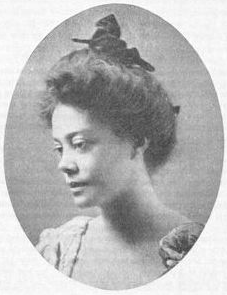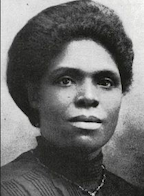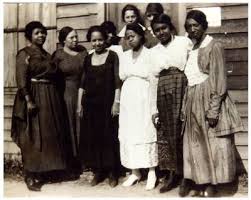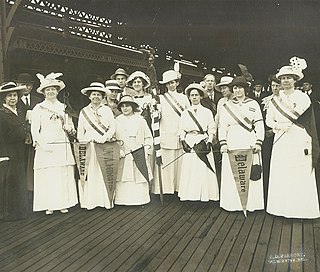
The National Woman's Party (NWP) was an American women's political organization formed in 1916 to fight for women's suffrage. After achieving this goal with the 1920 adoption of the Nineteenth Amendment to the United States Constitution, the NWP advocated for other issues including the Equal Rights Amendment. The most prominent leader of the National Woman's Party was Alice Paul, and its most notable event was the 1917–1919 Silent Sentinels vigil outside the gates of the White House.

Alice Dunbar Nelson was an American poet, journalist, and political activist. Among the first generation of African Americans born free in the Southern United States after the end of the American Civil War, she was one of the prominent African Americans involved in the artistic flourishing of the Harlem Renaissance. Her first husband was the poet Paul Laurence Dunbar. After his death, she married physician Henry A. Callis; and, lastly, was married to Robert J. Nelson, a poet and civil rights activist. She achieved prominence as a poet, author of short stories and dramas, newspaper columnist, women's rights activist, and editor of two anthologies.
Annie Arniel was a suffragist and women's rights advocate. Born in Harrington, Delaware as Anna L. Melvin, she married George Arniel of Canada and was widowed in 1910. Annie played a key role in helping to win the women's vote in the United States.

Mabel Vernon was an American suffragist, pacifist, and a national leader in the United States suffrage movement. She was a Quaker and a member of the National American Woman Suffrage Association. Vernon was inspired by the methods used by the Women's Social and Political Union in Britain. Vernon was one of the principal members of the Congressional Union for Women Suffrage (CUWS) alongside Olympia Brown, Inez Milholland, Crystal Eastman, Lucy Burns, and Alice Paul, and helped to organize the Silent Sentinels protests that involved daily picketing of Woodrow Wilson's White House.

Nina Evans Allender was an American artist, cartoonist, and women's rights activist. She studied art in the United States and Europe with William Merritt Chase and Robert Henri. Allender worked as an organizer, speaker, and campaigner for women's suffrage and was the "official cartoonist" for the National Woman's Party's publications, creating what became known as the "Allender Girl."

Helen Wormley Anderson (1877–1962) was an African-American suffragist.

Violet A. Johnson was an American civic leader and suffragist.
Blanche Willams Stubbs was an American civil rights activist and suffragist. A prominent activist in Wilmington, Delaware, in 2019 it was announced that she was to be inducted into the Hall of Fame of Delaware Women.

The women's suffrage movement began in California in the 19th century and was successful with the passage of Proposition 4 on October 10, 1911. Many of the women and men involved in this movement remained politically active in the national suffrage movement with organizations such as the National American Women's Suffrage Association and the National Woman's Party.

Fannie Hopkins Hamilton(1882 – 1964) was a dress maker and suffragist who joined the Equal Suffrage Study Club and uplifted the black community in Wilmington, Delaware. She was a leader, contributor, activist, and supportive teacher throughout her life as a suffragist.

Women's suffrage began in Illinois began in the mid-1850s. The first women's suffrage group was formed in Earlville, Illinois, by the cousin of Susan B. Anthony, Susan Hoxie Richardson. After the Civil War, former abolitionist Mary Livermore organized the Illinois Woman Suffrage Association (IWSA), which would later be renamed the Illinois Equal Suffrage Association (IESA). Frances Willard and other suffragists in the IESA worked to lobby various government entities for women's suffrage. In the 1870s, women were allowed to serve on school boards and were elected to that office. The first women to vote in Illinois were 15 women in Lombard, Illinois, led by Ellen A. Martin, who found a loophole in the law in 1891. Women were eventually allowed to vote for school offices in the 1890s. Women in Chicago and throughout Illinois fought for the right to vote based on the idea of no taxation without representation. They also continued to expand their efforts throughout the state. In 1913, women in Illinois were successful in gaining partial suffrage. They became the first women east of the Mississippi River to have the right to vote in presidential elections. Suffragists then worked to register women to vote. Both African-American and white suffragists registered women in huge numbers. In Chicago alone 200,000 women were registered to vote. After gaining partial suffrage, women in Illinois kept working towards full suffrage. The state became the first to ratify the Nineteenth Amendment, passing the ratification on June 10, 1919. The League of Women Voters (LWV) was announced in Chicago on February 14, 1920.

Women's suffrage began in Delaware the late 1860s, with efforts from suffragist, Mary Ann Sorden Stuart, and an 1869 women's rights convention held in Wilmington, Delaware. Stuart, along with prominent national suffragists lobbied the Delaware General Assembly to amend the state constitution in favor of women's suffrage. Several suffrage groups were formed early on, but the Delaware Equal Suffrage Association (DESA) formed in 1896, would become one of the major state suffrage clubs. Suffragists held conventions, continued to lobby the government and grow their movement. In 1913, a chapter of the Congressional Union (CU), which would later be known at the National Woman's Party (NWP), was set up by Mabel Vernon in Delaware. NWP advocated more militant tactics to agitate for women's suffrage. These included picketing and setting watchfires. The Silent Sentinels protested in Washington, D.C., and were arrested for "blocking traffic." Sixteen women from Delaware, including Annie Arniel and Florence Bayard Hilles, were among those who were arrested. During World War I, both African-American and white suffragists in Delaware aided the war effort. During the ratification process for the Nineteenth Amendment, Delaware was in the position to become the final state needed to complete ratification. A huge effort went into persuading the General Assembly to support the amendment. Suffragists and anti-suffragists alike campaigned in Dover, Delaware for their cause. However, Delaware did not ratify the Nineteenth Amendment until March 6, 1923, well after it was already part of the United States Constitution.

This is a timeline of women's suffrage in Delaware. Suffragists in Delaware began to fight for women's suffrage in the late 1860s. Mary Ann Sorden Stuart and national suffragists lobbied the Delaware General Assembly for women's suffrage. In 1896, the Delaware Equal Suffrage Association (DESA) was formed. Annual state suffrage conventions were held. There were also numerous attempts to pass an equal suffrage amendment to the Delaware State Constitution, but none were successful. In 1913, a state chapter of the Congressional Union (CU) was opened by Mabel Vernon. Delaware suffragists are involved in more militant tactics, including taking part of the Silent Sentinels. On March 22, 1920, Delaware had a special session of the General Assembly to consider ratification of the Nineteenth Amendment. It was not ratified by Delaware until 1923.

Nellie Blythe Nicholson Taylor was an African-American suffragist and educator.
Emma Belle Gibson Sykes was a suffragist and civil rights activist.

Edwina Kruse was an American educator, born in Puerto Rico. She was principal of Howard High School in Wilmington, Delaware for almost 40 years, and a close associate of Alice Dunbar-Nelson, who taught at Howard.
The Wilmington Equal Suffrage Study Club (WESSC) was the name of an African American women's suffrage organization, founded in Wilmington, Delaware, in March 1914.
Susie Estella Palmer Hamilton (1862-1942) was a suffragist and activist in Wilmington, Delaware, and a founding member of the Equal Suffrage Study Club.

Mary Clare Laurence Brassington was an American suffragist, president of the Delaware Equal Suffrage Association (DESA) from 1915 to 1917.